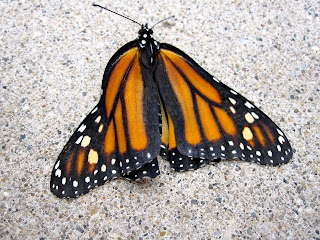 Ruby Throated Hummingbirds are feeding heavily right now, adding weight for their flight south. Ruby Throated hummers weigh less than a nickel and 1/2 of their weight is in the pectoral muscles of their breasts which are the muscles needed for flight. While Hummingbirds frequent backyard feeders they prefer natural sucrose and small insects. It takes them about 20 minutes to digest the sucrose and they are 97% efficient at converting the sucrose to energy. Hummingbirds do not suck nectar through their beaks but lick the nectar with their raspy tongues. Males begin the migration a few days before the females in order to establish their territories in the wintering and breeding sites. Ruby Throated Hummingbirds are feeding heavily right now, adding weight for their flight south. Ruby Throated hummers weigh less than a nickel and 1/2 of their weight is in the pectoral muscles of their breasts which are the muscles needed for flight. While Hummingbirds frequent backyard feeders they prefer natural sucrose and small insects. It takes them about 20 minutes to digest the sucrose and they are 97% efficient at converting the sucrose to energy. Hummingbirds do not suck nectar through their beaks but lick the nectar with their raspy tongues. Males begin the migration a few days before the females in order to establish their territories in the wintering and breeding sites. |
| Female Ruby Throated Hummingbird feeding in Jewelweed 9/15/13 |
Sunday, September 15, 2013
Got Nectar?
Friday, September 13, 2013
Twin Girls!!
God speed, little ladies!
Thursday, September 12, 2013
IT'S A GIRL!
A PICTURE'S WORTH A THOUSAND WORDS.
THIS SEQUENCE TOOK PLACE IN THE LAST COUPLE OF HOURS.
THANKS TO SUE PETERS FOR SHARING HER PHOTOS.
It won't be long now!
While the Monarch caterpillars formed their chrysalis within a few hours of each other they are at different stages of development at day 10. It looks like they are on schedule to soon make the flight to the Sierra Madre Mountains of Mexico. The black crumb climging to the left chrysalis is the remains of the caterpillar skin after the formation of the chrysalis.
Photo: Sue Peters
Wednesday, September 11, 2013
"Is it FALL yet?"
When it is 95 degrees F. and the dew point is over 70 degrees how do you keep cool when you just can't get to air conditioning? If your a Fox Squirrel you just find a shady branch on a Mulberry Tree and hang out.
Thursday, September 5, 2013
On the Way to Adulthood
Wednesday, September 4, 2013
Growing Up On Milkweed
 | ||
| As received 8-28-2013
|
9-4-2013, 6:05 PM
Photos by Sue Peters, Allen Co., Indiana
A Room With A View
Humans provide many opportunities for our feathered and furry friends to lead a more comfortable and productive life. Bird feeders are just an example of out attempts to entice song birds to our backyards for the simple joy of watching birds eat and just live life. On the down side, bird eating raptors find well stocked bird feeders an open buffet with a great selection. On the plus side, some members of the wildlife community find the feeders cozy and welcoming. Some designs work better than others.
The only problem here is that "Rocky" seems to be sitting in his dinner plate.
Photo by:
Jonathan Ormiston
Noble Co., IN
This female Flying Squirrel is raising two youngsters where all the world can see.
Photo:
Deer Run - Allen County Parks
Allen Co., IN
Flying Squirrels, in Indiana, are not often seen during daylight hours. While a more correct term would be "Gliding" Squirrel, they have developed an excellent way to move about the forest expending the least amount of energy. This mother seemed very calm about having visitors as she groomed and cared for her naked young.
The only problem here is that "Rocky" seems to be sitting in his dinner plate.
Photo by:
Jonathan Ormiston
Noble Co., IN
 |
| This design seems to work well for raising a family also. |
Photo:
Deer Run - Allen County Parks
Allen Co., IN
Flying Squirrels, in Indiana, are not often seen during daylight hours. While a more correct term would be "Gliding" Squirrel, they have developed an excellent way to move about the forest expending the least amount of energy. This mother seemed very calm about having visitors as she groomed and cared for her naked young.
Subscribe to:
Comments (Atom)

















